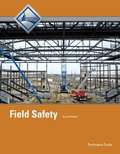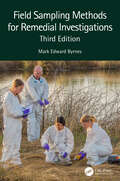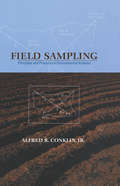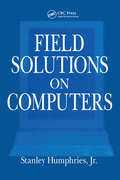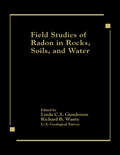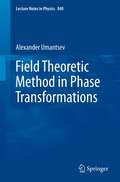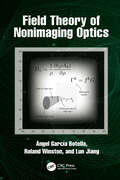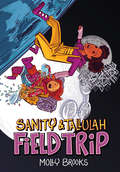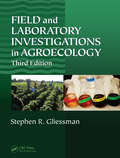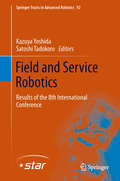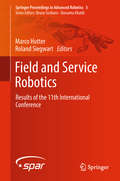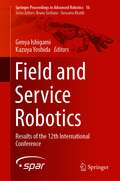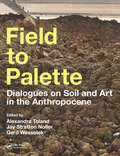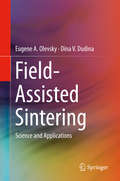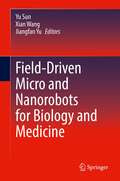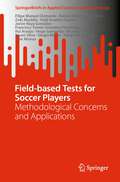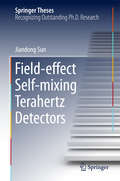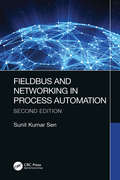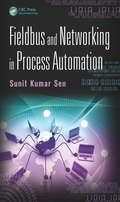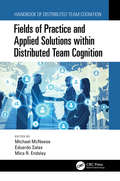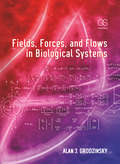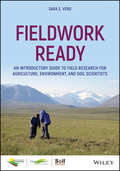- Table View
- List View
Field Safety
by National Center for Construction Education Research StaffThis exceptionally produced trainee guide features a highly illustrated design, technical hints and tips from industry experts, review questions and a whole lot more! Key content includes: Introduction to Safety, Introdcution to Materials Handling, Confined Spaces, Work-Zone Safety, Electrical Safety, Working from Elevations, Welding Safety, Steel Erection, Motorized Equipment Safety, Crane Safety, Rigging Practices, and Concrete and Masonry. Instructor Supplements
Field Sampling Methods for Remedial Investigations
by Mark Edward ByrnesOriginally published in 1994, the first edition of Field Sampling Methods for Remedial Investigations soon became a premier resource in this field. The "Princeton Groundwater" course designated it as one of the top books on the market that addresses strategies for groundwater characterization, groundwater well installation, well completion, and groundwater sampling. This long awaited third edition provides most current and most cost-effective environmental media characterization methods and approaches supporting all aspects of remediation activities. This book integrates recommendations from over one hundred of the most current US EPA, State EPA, US Geological Survey, US Army Corps of Engineers, and National Laboratory environmental guidance and/or technical documents. This book provides guidance, examples, and/or case studies for the following subjects: Implementing the EPA’s latest Data Quality Objectives process Developing cost effective statistical & non-statistical sampling designs supporting all aspects of environmental remediation activities, and available statistical sample design software Aerial photography, surface geophysics, airborne/surface/downhole/building radiological surveys, soil gas surveying, environmental media sampling, DNAPL screening, portable X-ray fluorescence measurements Direct push groundwater sampling, well installation, well development, well purging, no-purge/low-flow/standard groundwater sampling, depth-discrete ground sampling, groundwater modeling Tracer testing, slug testing, waste container and building material sampling, pipe surveying, defining background conditions Documentation, quality control sampling, data verification/validation, data quality assessment, decontamination, health & safety, management of investigation waste A recognized expert on this subject, author Mark Byrnes provides standard operating procedures and guidance on the proper implementation of these methods, focusing on proven technologies that are acknowledged by EPA and State regulatory agencies as reputable techniques.
Field Sampling: Principles and Practices in Environmental Analysis (Books in Soils, Plants, and the Environment)
by Alfred R. Conklin Jr.Written by a renowned professional with more than 30 years of experience in environmental sampling and analysis, this reference describes in unparalleled detail all the essential elements for the development and execution of a successful sampling plan at both contaminated and uncontaminated sites. The book covers presampling planning and decision-making, specific sampling situations, and correct sample labeling, and presents the framework and background for the sampling of any contaminated site. Presenting a wide variety of models, quality control procedures, and valuable troubleshooting methods, Field Sampling contains an abundance of topics never before covered in any other source.
Field Solutions on Computers
by Stanley Humphries Jr.Field Solutions on Computers covers a broad range of practical applications involving electric and magnetic fields. The text emphasizes finite-element techniques to solve real-world problems in research and industry. After introducing numerical methods with a thorough treatment of electrostatics, the book moves in a structured sequence to advanced topics. These include magnetostatics with non-linear materials, permanent magnet devices, RF heating, eddy current analysis, electromagnetic pulses, microwave structures, and wave scattering. The mathematical derivations are supplemented with chapter exercises and comprehensive reviews of the underlying physics. The book also covers essential supporting techniques such as mesh generation, interpolation, sparse matrix inversions, and advanced plotting routines.
Field Studies of Radon in Rocks, Soils, and Water
by Linda C. Gundersen Richard B. WantyField Studies of Radon in Rocks, Soils, and Water focuses on the principal sources of indoor radon and detecting radon through geochemical and hydrological studies of ground water. The book addresses how to measure radon, covers geological field study techniques, and presents techniques for assessing radon potential. The geochemical and hydrological studies of ground water cover such areas as health effects and radionuclides in geology. Techniques for measuring radon in ground water are also provided. Field Studies of Radon in Rocks, Soils, and Water is an excellent practical guide for geologists, geochemists, ground water professionals, and geophysicists interested in radon.Features
Field Theoretic Method in Phase Transformations
by Alexander UmantsevThe main subject of the book is the continuum, field theoretic method of study of phase transformations in material systems. The method, also known as "phase field", allows one to analyze different stages of transformations on the unified platform. It has received significant attention in the materials science community recently due to many successes in solving or illuminating important problems. The book will address fundamentals of the method starting from the classical theories of phase transitions, the most important theoretical and computational results, and some of the most advanced recent applications.
Field Theories of Condensed Matter Physics
by Eduardo FradkinPresenting the physics of the most challenging problems in condensed matter using the conceptual framework of quantum field theory, this book is of great interest to physicists in condensed matter and high energy and string theorists, as well as mathematicians. Revised and updated, this second edition features new chapters on the renormalization group, the Luttinger liquid, gauge theory, topological fluids, topological insulators and quantum entanglement. The book begins with the basic concepts and tools, developing them gradually to bring readers to the issues currently faced at the frontiers of research, such as topological phases of matter, quantum and classical critical phenomena, quantum Hall effects and superconductors. Other topics covered include one-dimensional strongly correlated systems, quantum ordered and disordered phases, topological structures in condensed matter and in field theory and fractional statistics.
Field Theory of Nonimaging Optics
by Roland Winston Lun Jiang Angel Garcia-BotellaThis book aims to overcome the traditional ray paradigm and provide an analytical paradigm for Nonimaging Optics based on Field Theory. As a second objective, the authors address the connections between this Field Theory of Nonimaging Optics and other radiative transfer theories. The book introduces the Field Theory of Nonimaging Optics as a new analytical paradigm, not statistical, to analyze problems in the frame of nonimaging geometrical optics, with a formulation based on field theory of irradiance vector D. This new paradigm provides new principles and tools in the optical system design methods, complementary to flowline method, overcoming the classical ray paradigm. This new Field paradigm can be considered as a generalization of the ray paradigm and new accurate and faster computation algorithms will be developed. In a parallel way, the advance in the knowledge of the principles of Field Theory of Nonimaging Optics has produced clear advances in the connection between nonimaging optics and other apparently disconnected theories of radiation transfer. The irradiance vector D can be considered as the macroscopic average of Poynting vector, with a clear connection with radiation pressure. Lorentz geometry techniques can also be applied to study irradiance vector D. There are clear thermodynamic connections between the nonimaging concentrator and Stefan-Boltzmann law of radiation. From this thermodynamic connection, nonimaging optics and irradiance vector D can also be studied from a phase space point of view. This book is intended for researchers, graduate students, academics and professionals looking to analyze, design and optimize optical systems.
Field Trip (Sanity & Tallulah #2)
by Molly BrooksSanity and Tallulah are going on a field trip-to a real live planet! Some of their classmates are nervous (none of them have been on a planet before, and they've heard terrible things), but Tallulah is beside herself with excitement. Sanity would be more excited if her grumpy older sister, Prudence, wasn't coming along to supervise the trip. Things get off to a rocky start (asteroid-y start, to be specific) and Sanity and Tallulah find themselves separated from their school group, pursued by a pirate, and stranded on a planet that's about to explode, with nothing but the wreckage of a crashed space shuttle and the contents of Tallulah's overloaded backpack to work with. These best friends will have to stretch their problem-solving skills to the limit in order to get everyone home safe, and it's going to take their whole class-plus an accountant, a math hermit, a group of mysterious beekeepers, and even the murderous pirate-to make it happen.This second adventure in the Sanity & Tallulah series by Molly Brooks is out of this world!
Field and Laboratory Investigations in Agroecology
by Stephen R. GliessmanAgroecology is defined as the application of ecological concepts and principles to the design and management of sustainable food systems. Hence, learning can best be achieved through an experiential approach to the topic. Designed to accompany Agroecology: The Ecology of Sustainable Food Systems, Third Edition, Field and Laboratory Investigations i
Field and Service Robotics
by David S. Wettergreen Timothy D. BarfootThis bookcontains the proceedings of the 10th FSR, (Field and Service Robotics) which isthe leading single-track conference on applications of robotics in challengingenvironments. The 10th FSR was held in Toronto, Canada from 23-26June 2015. The book contains 42full-length, peer-reviewed papers organized into a variety of topics: Aquatic, Vision, Planetary, Aerial,Underground, and Systems. The goal ofthe book and the conference is to report and encourage the development andexperimental evaluation of field and service robots, and to generate a vibrantexchange and discussion in the community. Field robots are non-factory robots, typically mobile, that operate incomplex and dynamic environments: on theground (Earth or other planets), under the ground, underwater, in the air or inspace. Service robots are those thatwork closely with humans to help them with their lives. The first FSR was held in Canberra,Australia, in 1997. Since that firstmeeting, FSR has been held roughly every two years, cycling through Asia,Americas, Europe.
Field and Service Robotics
by Kazuya Yoshida Satoshi TadokoroFSR, the International Conference on Field and Service Robotics, is the leading single track conference of robotics for field and service applications. This book presents the results of FSR2012, the eighth conference of Field and Service Robotics, which was originally planned for 2011 with the venue of Matsushima in Tohoku region of Japan. However, on March 11, 2011, a magnitude M9. 0 earthquake occurred off the Pacific coast of Tohoku, and a large-scale disaster was caused by the Tsunami which resulted, therefore the conference was postponed by one year to July, 2012. In fact, this earthquake raised issues concerning the contribution of field and service robotics technology to emergency scenarios. A number of precious lessons were learned from operation of robots in the resulting, very real and challenging, disaster environments. Up-to-date study on disaster response, relief and recovery was then featured in the conference. This book offers 43 papers on a broad range of topics including: Disaster Response, Service/Entertainment Robots, Inspection/Maintenance Robots, Mobile Robot Navigation, Agricultural Robots, Robots for Excavation, Planetary Exploration, Large Area Mapping, SLAM for Outdoor Robots, and Elemental Technology for Mobile Robots.
Field and Service Robotics
by Roland Siegwart Marco HutterThis books presents the results of the 6th edition of "Field and Service Robotics" FSR03, held in Chamonix, France, July 2007. The conference provided a forum for researchers, professionals and robot manufacturers to exchange up-to-date technical knowledge and experience. This book offers a collection of a broad range of topics including: Underwater Robots and Systems, Autonomous Navigation for Unmanned Aerial Vehicles, Simultaneous Localization and Mapping, and Climbing Robotics.
Field and Service Robotics: Results of the 12th International Conference (Springer Proceedings in Advanced Robotics #16)
by Kazuya Yoshida Genya IshigamiThis book comprises select proceedings of the 12th Conference on Field and Service Robotics (FSR 2019) focusing on cutting-edge research carried out in different applications of robotics, including agriculture, search and rescue, aerial marine, industrial, and space. It focuses on experiments and demonstrations of robotics applied to complex and dynamic environments and covers diverse applications. The essays are written by leading international experts, making it a valuable resource for researchers and practicing engineers alike.
Field to Palette: Dialogues on Soil and Art in the Anthropocene
by Alexandra Toland Jay Stratton Noller Gerd WessolekField to Palette: Dialogues on Soil and Art in the Anthropocene is an investigation of the cultural meanings, representations, and values of soil in a time of planetary change. The book offers critical reflections on some of the most challenging environmental problems of our time, including land take, groundwater pollution, desertification, and biodiversity loss. At the same time, the book celebrates diverse forms of resilience in the face of such challenges, beginning with its title as a way of honoring locally controlled food production methods championed by "field to plate" movements worldwide. By focusing on concepts of soil functionality, the book weaves together different disciplinary perspectives in a collection of dialogue texts between artists and scientists, interviews by the editors and invited curators, essays and poems by earth scientists and humanities scholars, soil recipes, maps, and DIY experiments. With contributions from over 100 internationally renowned researchers and practitioners, Field to Palette presents a set of visual methodologies and worldviews that expand our understanding of soil and encourage readers to develop their own interpretations of the ground beneath our feet.
Field-Assisted Sintering: Science and Applications
by Eugene A. Olevsky Dina V. DudinaThis book represents the first ever scientific monograph including an in-depth analysis of all major field-assisted sintering techniques. Until now, the electromagnetic field-assisted technologies of materials processing were lacking a systematic and generalized description in one fundamental publication; this work promotes the development of generalized concepts and of comparative analyses in this emerging area of materials fabrication. This book describes modern technologies for the powder processing-based fabrication of advanced materials. New approaches for the development of well-tailored and stable structures are thoroughly discussed. Since the potential of traditional thermo-mechanical methods of material treatment is limited due to inadequate control during processing, the book addresses ways to more accurately control the resultant material's structure and properties by an assisting application of electro-magnetic fields. The book describes resistance sintering, high-voltage consolidation, sintering by low-voltage electric pulses (including spark plasma sintering), flash sintering, microwave sintering, induction heating sintering, magnetic pulse compaction and other field-assisted sintering techniques. Includes an in-depth analysis of all major field-assisted sintering techniques;Explains new techniques and approaches for material treatment;Provides detailed descriptions of spark plasma sintering, microwave sintering, high-voltage consolidation, magnetic pulse compaction, and various other approaches when field-assisted treatment is applied.
Field-Driven Micro and Nanorobots for Biology and Medicine
by Yu Sun Xian Wang Jiangfan YuThis book describes the substantial progress recently made in the development of micro and nanorobotic systems, utilizing magnetic, optical, acoustic, electrical, and other actuation fields. It covers several areas of micro and nanorobotics including robotics, materials science, and biomedical engineering. Field-Driven Micro and Nanorobots for Biology and Medicine provides readers with fundamental physics at the micro and nano scales, state-of-the-art technical advances in field-driven micro and nanorobots, and applications in biological and biomedical disciplines.
Field-based Tests for Soccer Players: Methodological Concerns and Applications (SpringerBriefs in Applied Sciences and Technology)
by Filipe Manuel Clemente José Afonso Hugo Sarmento Bruno Silva Rafael Oliveira Rui Silva Zeki Akyildiz Halil Ibrahim Ceylan Javier Raya González Francisco Tomás Fernández Rui Araújo Ricardo Lima Sérgio Matos Yung-Sheng ChenThis book systematically summarizes the accuracy, precision, and repeatability levels of field-based tests applied in soccer. It considers such details as the effectiveness of tests for different age categories and sexes. In this book, the readers will be able to check all the field-based tests conceived for fitness assessment in soccer through a large systematic review made to the literature. In addition a brief characterization of each test and presentation of the concurrent validity and repeatability levels for each test will be provided. Finally, the book contains a general discussion of the implications of the tests for different methodological approaches to training. It will be use to sports scientists and practitioners.
Field-effect Self-mixing Terahertz Detectors
by Jiandong SunA comprehensive device model considering both spatialdistributions of the terahertz field and the field-effect self-mixing factorhas been constructed for the first time in the thesis. The author has foundthat it is the strongly localized terahertz field induced in a small fractionof the gated electron channel that plays an important role in the highresponsivity. An AlGaN/GaN-based high-electron-mobility transistor with a2-micron-sized gate and integrated dipole antennas has been developed and canoffer a noise-equivalent power as low as 40 pW/Hz1/2 at 900 GHz. By furtherreducing the gate length down to 0. 2 micron, a noise-equivalent power of 6pW/Hz1/2 has been achieved. This thesis provides detailed experimentaltechniques and device simulation for revealing the self-mixing mechanismincluding a scanning probe technique for evaluating the effectiveness ofterahertz antennas. As such, the thesis could be served as a valuableintroduction towards further development of high-sensitivity field-effect terahertzdetectors for practical applications.
Fieldbus and Networking in Process Automation
by Sunit Kumar SenOver the last two decades, fieldbus has totally revolutionized the way communication takes place in the fields of process control, automation, and manufacturing industries. Recent introduction of real-time fieldbuses has opened up its application in multi-axis motor control and other time-critical applications. Fieldbus is designed to ensure easy interoperability, smarter network designs, increased data availability, and lessened stress on the design aspects of safety protocols. This second edition of Fieldbus and Networking in Process Automation discusses the different facets of fieldbus technology including design, wiring, installation, and commissioning as well as safety aspects in hostile application areas. The book: • Explains basic communication principles and networking—a must for understanding fieldbuses • Considers the advantages and shortcomings of individual fieldbuses • Provides a broad spectrum of different fieldbuses used in both process control and manufacturing industries in a precise and to-the-point manner • Introduces Common Industrial Protocol (CIP), EtherNet/IP, EtherCAT, SERCOS III, Powerlink, and Profinet IRT, which are mostly sought after in control and automation fields • Discusses hard real-time communication in a succinct manner—so essential in today’s multi-axis motor control systems • Updates and streamlines the extra details from the original book to make it more concise and reader friendly Sunit Kumar Sen, a member of IET, holds advanced degrees from St Xavier’s College and University of Calcutta, both in Kolkata, India. He was an ex-professor in the Instrumentation Engineering section of the Department of Applied Physics, University of Calcutta, and taught courses in digital electronics, communication, industrial instrumentation, microprocessors, electrical networks, and fieldbuses. He was the head of the Department of Applied Physics and University Science Instrumentation Center from 2008-2010 at the University of Calcutta. Previously, he was assistant manager, instrumentation (oprn.) at the Bokaro Steel Plant, Jharkhand, India, under the Steel Authority of India (SAIL). He has already written four books in the areas of instrumentation, microprocessors, and industrial automation technologies. He has been published in approximately 70 national and international journals and conferences.
Fieldbus and Networking in Process Automation
by Sunit SenFieldbuses, particularly wireless fieldbuses, offer a multitude of benefits to process control and automation. Fieldbuses replace point-to-point technology with digital communication networks, offering increased data availability and easier configurability and interoperability. Fieldbus and Networking in Process Automation discusses the newest fieldbuses on the market today, detailing their utilities, components and configurations, wiring and installation methods, commissioning, and safety aspects under hostile environmental conditions. This clear and concise text: Considers the advantages and shortcomings of the most sought after fieldbuses, including HART, Foundation Fieldbus, and Profibus Presents an overview of data communication, networking, cabling, surge protection systems, and device connection techniques Provides comprehensive coverage of intrinsic safety essential to the process control, automation, and chemical industries Describes different wireless standards and their coexistence issues, as well as wireless sensor networks Examines the latest offerings in the wireless networking arena, such as WHART and ISA100.11a Offering a snapshot of the current state of the art, Fieldbus and Networking in Process Automation not only addresses aspects of integration, interoperability, operation, and automation pertaining to fieldbuses, but also encourages readers to explore potential applications in any given industrial environment.
Fields and Waves in Electromagnetic Communications
by Nemai Chandra KarmakarFIELDS AND WAVES IN ELECTROMAGNETIC COMMUNICATIONS A vital resource that comprehensively covers advanced topics in applied electromagnetics for the professional Electromagnetism (EM) is a highly abstract and complex subject that examines how exerting a force on charged particles is affected by the presence and motion of adjacent particles. The interdependence of the time varying electric and magnetic fields—one producing the other, and vice versa—has allowed researchers to consider them as a single coherent entity: the electromagnetic field. Under this umbrella, students can learn about numerous and varied topics, such as wireless propagation, satellite communications, microwave technology, EM techniques, antennas, and optics, among many others. Fields and Waves in Electromagnetic Communications covers advanced topics in applied electromagnetics for the professional by offering a comprehensive textbook that covers the basics of EM to the most advanced topics such as the classical electron theory of matters, the mechanics model and macroscopic model. Specifically, the book provides a welcome all-in-one source on wireless and guided EM that deals in a wide range of subjects: transmission lines, impedance matching techniques, metallic waveguides, resonators, optical waveguides, optical fibres, antennas, antenna arrays, wireless systems, and electromagnetic compatibility (EMC), and more. The content is supported with innovative pedagogy, the most recent reports and working principles of relevant and contemporary technological developments including applications, specialist software tools, laboratory experiments, and innovative design projects. Fields and Waves in Electromagnetic Communications readers will also find: Multiple practical examples, similes and illustrations of interdisciplinary topics related to wireless and guided electromagnetism Explanations of new topics with support of basic theories connected to real-world contexts and associated applications Sets of technology applications that rely on advanced electromagnetism A series of review questions and drills, end-of-chapter problems, and exercises to help enforce what was learned in each chapter Fields and Waves in Electromagnetic Communications is an ideal textbook for graduate students and senior undergraduates studying telecommunication and wireless communication. It is also a useful resource for industry engineers and members of defense services. Moreover, the book is an excellent non-specialist engineering reference able to be used in other disciplines, such as biomedical engineering, mechatronics, computer science, materials engineering, civil and environmental engineering, physics, network engineering, and wireless services.
Fields of Practice and Applied Solutions within Distributed Team Cognition
by Michael D. McNeese; Eduardo Salas; Mica R. EndsleyMany different cognitive research approaches have been generated to explore fields of practice where mutual teamwork is present and emergent. Results have shown subtle yet significant findings on how humans actually work together and when they transition from their own individual roles and niches into elements of teamwork and team-to-team work. Fields of Practice and Applied Solutions within Distributed Team Cognition explores the advantages of teams and shows how researchers can obtain a deep understanding of users/teams that are entrenched in a particular field. Interdisciplinary perspectives and transformative intersections are provided. Features Delineates contextual nuances of socio-technical environments as influencers of team cognition Provides quantitative/qualitative perspectives of distributed team cognition by demonstrating in situ interactions Reviews applied teamwork for fields of practice in medicine, cybersecurity, education, aviation, and manufacturing Generates practical examples of distributed work and how cognition develops across teams using technologies Specifies applied solutions through technologies such as robots, agents, games, and social networks
Fields, Forces, and Flows in Biological Systems
by Alan J GrodzinskyFields, Forces, and Flows in Biological Systems describes the fundamental driving forces for mass transport, electric current, and fluid flow as they apply to the biology and biophysics of molecules, cells, tissues, and organs. Basic mathematical and engineering tools are presented in the context of biology and physiology.The chapters are structured in a framework that moves across length scales from molecules to membranes to tissues. Examples throughout the text deal with applications involving specific biological tissues, cells, and macromolecules. In addition, a variety of applications focus on sensors, actuators, diagnostics, and microphysical measurement devices (e.g., bioMEMs/NEMs microfluidic devices) in which transport and electrokinetic interactions are critical.This textbook is written for advanced undergraduate and graduate students in biological and biomedical engineering and will be a valuable resource for interdisciplinary researchers including biophysicists, physical chemists, materials scientists, and chemical, electrical, and mechanical engineers seeking a common language on the subject.
Fieldwork Ready: An Introductory Guide to Field Research for Agriculture, Environment, and Soil Scientists (ASA, CSSA, and SSSA Books)
by Sara E. VeroDiscover how to plan, conduct, and interpret field research with this essential new guidebook Good field research is the driving force behind advancement in the agronomic, environmental, and soil sciences. Nevertheless, many undergraduate and graduate scientists have limited opportunity to develop hands-on experience before undertaking projects in the field. With Fieldwork Ready, Dr Sara Vero maps out the fundamental principles, methods, and management techniques that underpin this crucial practice, offering trainee researchers an accessible introduction to the world of on-site investigation. This instructive text includes: Guidance on the essential aspects of environmental monitoring and soil, water, plant, and wildlife research Insights into the methods behind experiment planning and effective fieldwork Tips for team management and safety Explanations of how to select and correctly use soil sampling equipment Offering new researchers a primer that is practical and easy to follow, Fieldwork Ready is the ideal starting point for all those beginning a career in the agricultural sciences.
